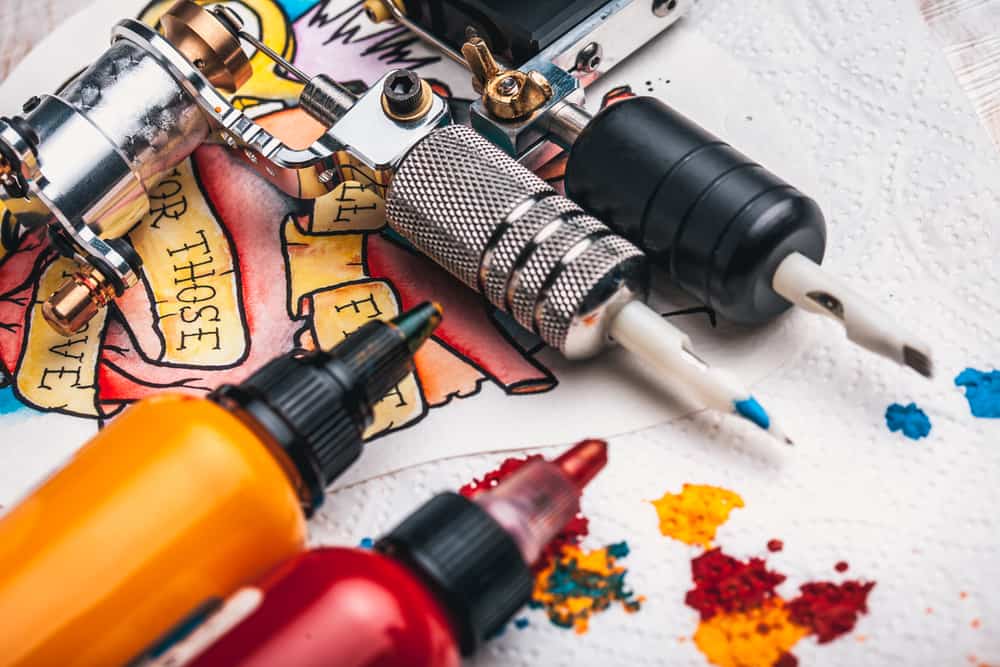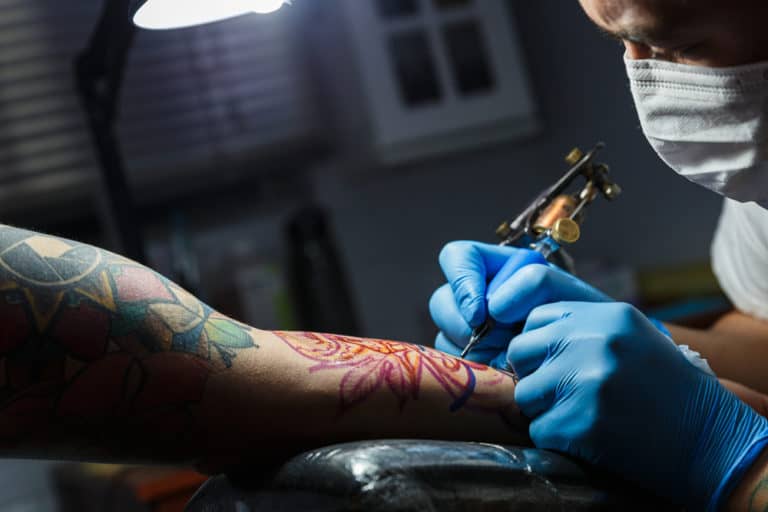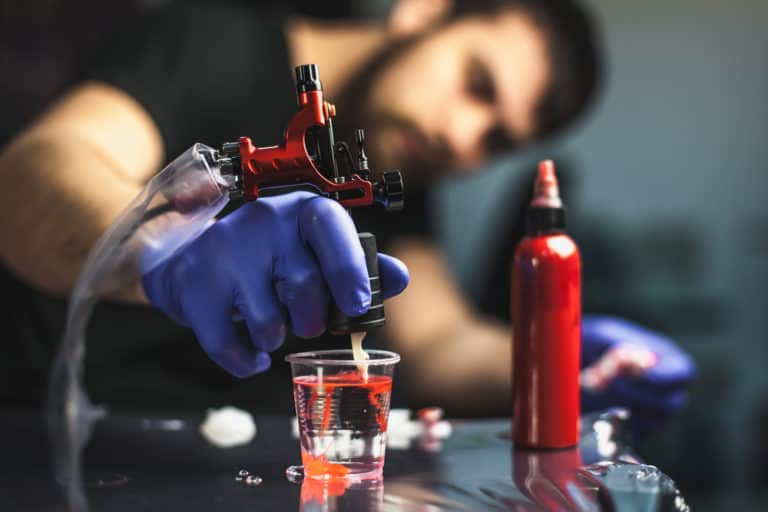Tattoo Ink vs Pen Ink: What’s The Difference?
The age-old question of whether you can use pen ink for tattoos is one that needs to be answered. Countless times I have come across people who are curious to explore the world of tattoos with pen ink, but this is a no-go!
Tattoo ink and pen ink differ in their purpose and composition. Tattoo ink is most commonly pigment-based within a carrier fluid, whereas pen ink consists of dye mixed with chemicals. Furthermore, tattoo ink is injected into the skin, whereas pen ink is used on inorganic substances.
Let’s explore the world of tattoo ink, and maybe you will learn a thing or two about this ancient technique you never knew. Included is an excellent and straightforward 5-step process on how to make your homemade ink so that you never have to consider using pen ink again!
Is Tattoo Ink The Same As Pen Ink?
Tattoo ink is not the same as pen ink. These two types of ink differ in two fundamental ways: their composition and their purpose.
Tattoo Ink Vs. Pen Ink: Composition
Tattoo ink and pen ink are made up of different things.
Tattoo ink is made up of pigments mixed with a carrier substance. The pigment bases that are most commonly used are metal salts, iron oxides, or plastics. The carrier substance is used as a solvent for the pigment so that the ink can easily move into the skin.
The carrier substances are often alcohol-based, such as ethyl alcohol, methanol, rubbing alcohol, etc., but, occasionally tattoo ink contains distilled water instead. The reason alcohol is more commonly used than distilled water is that it increases the skin’s permeability so the ink can pass more easily into the skin. It also helps sterilize the ink.
On the other hand, pen ink is a mixture of various dyes (instead of pigments) combined with chemicals. Pen ink also includes preservatives so that the ink remains liquid within the pen for a lengthy period of time.
Tattoo Ink Vs. Pen Ink: Purpose
Another fairly noticeable difference between the two types of ink is their purpose.
Tattoo ink is used for…you guessed it, tattoos! Pen ink, however, has multiple uses and is applied to many inorganic substances.
Can You Use Pen Ink As Tattoo Ink?
You cannot and should not use pen ink as tattoo ink. Using pen ink for tattoos can lead to serious infections and make someone quite sick.
Pen ink is not sterile like tattoo ink and contains substances toxic to the body, so placing this under your skin is NOT a good idea. The pen ink composition, such as the dye and chemicals, does not react well with the body. If you’d like a tattoo, it is best to let the professionals use their proper ink.
Stick And Poke Tattoos With Pen Ink
It is pretty common for people experimenting with first-time stick-and-poke at home to test out this type of tattooing with any ink they can find. Many who have done this wonder whether the ink from their pen is a good idea. The answer is no.
As mentioned previously, you should not use pen ink as it is not sterile, unlike professional tattoo ink. Stick-and-poke is very tempting to try at home because it does not require a professional tattoo machine, but this does not make it any better for the use of pen ink.
Although stick-and-poke may not seem as serious as a professional tattoo, it still pushes the ink under the skin (if done correctly) and creates an open wound. Both these reasons explain why pen ink is not a good idea.
Please stick to professional tattoo ink to prevent infection and other nasty side effects. Plus, the tattoo will look a lot better!
Pen Ink Stick And Poke Side Effects
If you or a friend has tried out a stick-and-poke tattoo using pen ink and you are now stressing but don’t worry! Take the time to clean the tattoo with a sterilizing substance and watch it closely for the first few days.
Furthermore, you will need to look out for a few common side effects. Pen ink increases the risk of hepatitis and MRSA. Pen ink has also been associated with a wide variety of other serious infections because of the various bacteria and viruses that you may have exposed your skin to.
Please keep a lookout for the below common symptoms of pen ink poisoning:
- Skin infection
- Stained skin
- Upset stomach
- Issues with digestion
If you notice any of the above side effects or inflammation around the tattoo area that is not subsiding, take the time to visit your local doctor and get it checked out as soon as possible!
Stick And Poke: India Ink
While professional tattoo ink is always the best option, India ink is commonly used for stick-and-poke tattoos.
India ink is a safe option for stick-and-poke tattoos if professional ink is unavailable. This type of ink is non-toxic and cheap, so it is fun to experiment with without breaking the bank!
But be cautious when using India ink. It will not create the same results as professional tattoo ink and, depending on the make, might not be as sterile as one would like it to be.
Other Types Of Tattoo Ink
Aside from the traditional tattoo ink, which consists of simple pigments and carriers, there are five other common types of ink that are used for tattoos.
- Glow in the dark ink
- Backlight ink
- Removable tattoo ink
- Black henna
- Vegan tattoo ink
Glow in the dark tattoo ink is becoming increasingly popular. This fantastic ink glows with bright luminescent colors when the tattoo is in a dark environment. Crazy, I know! This type of ink is created to react to light due to the process of phosphorescence.
Secondly, you get backlight ink. This ink is very similar to glow-in-the-dark ink because it also glows! Backlight ink, however, does not glow due to phosphorescence but rather a fluorescence. Fluorescence means that it reacts to UV light.
The third type of tattoo ink is known as removable tattoo ink. Over the last few years, lasers have developed that can remove most types of tattoo ink, but it is still a long and painful process. However, more recently, a new type of ink has been brought to the market that is easier to remove than traditional ink.
Black henna is a type of tattoo ink; however, this is not typically placed under the skin but instead used externally. However, people have had bad reactions such as a rash, scars, itching, and blisters in the past, so Health Canada has advised against its use.
The last type of ink is vegan tattoo ink. This ink does not contain animal products that can occasionally be found in the traditional tattoo ink.
Best Types Of Tattoo Ink
Thousands of companies create tattoo ink, but I’ve summarized the top 5 below so that you don’t have to search long for your ideal ink.
Vegan ink is becoming increasingly popular due to its animal-cruelty-free nature, so the below list consists of only vegan-friendly products!
| Tattoo Ink | Features |
|---|---|
| Dynamic Black Ink | Vegan friendly Made in the USA Black: Available in 1 ounce and 8 ounces Color: Available in 1 ounce and 4 ounces best value for money in black ink |
| Kuro Sumi Tattoo Ink, Double Sumi Tribal Black | Vegan-Friendly Black: Available in 4 ounces Color: Available in 2 ounces to 6 ounces Available in color sets |
| Bloodline All Around Black 4-ounce Bottle | Vegan friendly Perfect for stick and poke tattoos Black: Available in 1ounce, 2 ounces, 4 ounces, and 8 ounces Water pigment carrier |
| Millennium Moms Tattoo Ink | Vegan-friendly Available in ½ ounce 7 bottle set Over 120 shades of color Great UV ray and backlight sensitive ink |
| Intense Color Tattoo Ink Sets 1 ounce | Vegan-friendly Available in 1 ounce, 19 bottles set Multiple options for different sets Interesting products such as pastel colors |
How To Make Tattoo Ink
While it is not ideal to use your tattoo ink – it is much better to make your own than use pen ink or other non-sterile options.
I will explain in a simple 5-step process how to make tattoo ink out of wood ashes. The final product will be sterile, which will reduce the risk of infection, and it is organic, which is always better.
Safety note: Please cover your mouth and nose with a mask and wear gloves before starting the five steps.
Making Tattoo Ink: Step 1
The first step is to make a fire. Take note of the type of wood you are using, as lighter wood will produce lighter ash, and darker wood will produce darker ash. Therefore, the wood type affects the color of the ink you will be creating.
Once you have lit the fire, you will need to leave it to burn until every last piece of wood has turned into ash. There must be no more “natural wood color” left in the ash; otherwise, this may affect the color of your pigment created.
Once the wood has completely turned into ash, you may leave it to cool.
Making Tattoo Ink: Step 2
Once the ash has cooled, you need to collect it and place it in a bowl so that you can grind it down into its finest state. If you have a mortar and pestle, this is perfect; otherwise, using a standard kitchen bowl and a stone will do the job.
Grind the ashes down until they are as fine as they can be!
Making Tattoo Ink: Step 3
The third step involves finding something that will sterilize the ashes. This sterilization is vital to prevent infection and any from bacteria getting into your skin.
Some professional tattoo inks use distilled water when creating ink, but I would not recommend using this as the risk of infection from homemade tattoo ink is a lot higher. Instead, use vodka, gin, or any other pure, clear spirit.
Please make sure that you don’t use alcohol with any color to it. For example, brandy is not a good idea. The transparent or white spirits are vital.
Making Tattoo Ink: Step 4
Now that you have your ground-up ashes and your clear spirit, it’s time to mix them!
The best way to do this is using a blender, as this will ensure that the alcohol and ash have mixed properly, unlike if you do it by hand. Take your ash and alcohol, place them in the blender, and then blend for 20 minutes. The result should be slurry in nature and have no larger chunks visible.
The proportion of ash to alcohol is hard to recommend due to many factors such as how much ash you used, what type of wood you used, what alcohol etc. So, it’s best to use your judgment.
Start with adding a little bit of liquid to the ash initially and then gradually increase until you reach that slurry consistency. Make sure you note exactly how much ash and alcohol you are adding!
Making Tattoo Ink: Step 5
The final step is to write down the exact amount of ash and liquid so that you can replicate this if you need more ink. If you do not have the precise measurements, you are less likely to create the exact same shade the next time around.
Well done, you have successfully made your homemade tattoo ink!
Conclusion
In conclusion, tattoo ink and pen ink differ in composition and purpose. Tattoo ink is made from a pigment mixed with a carrier, such as distilled water or alcohol. However, Pen ink is made from dye and chemicals. Therefore, pen ink should not be used as tattoo ink; otherwise, you increase the risk of infection.
Furthermore, stick and poke tattoos should also refrain from using pen ink but could use India ink, but professional tattoo ink is advisable.
References
- https://oureverydaylife.com/178408-what-is-the-difference-between-tattoo-ink-pen-ink.html
- https://en.wikipedia.org/wiki/Tattoo_ink
- https://www.bustle.com/articles/86711-how-to-make-your-stick-and-poke-tattoo-experience-as-safe-as-possible
- https://www.sculpey.com/create/blog/pigments-vs-dyes/
- https://www.wikihow.com/Make-Tattoo-Ink
- https://www.savedtattoo.com/can-you-use-pen-ink-for-stick-and-poke-tattoo/
- https://www.savedtattoo.com/can-you-use-pen-ink-for-stick-and-poke-tattoo/







